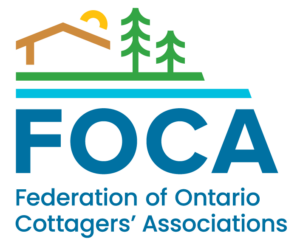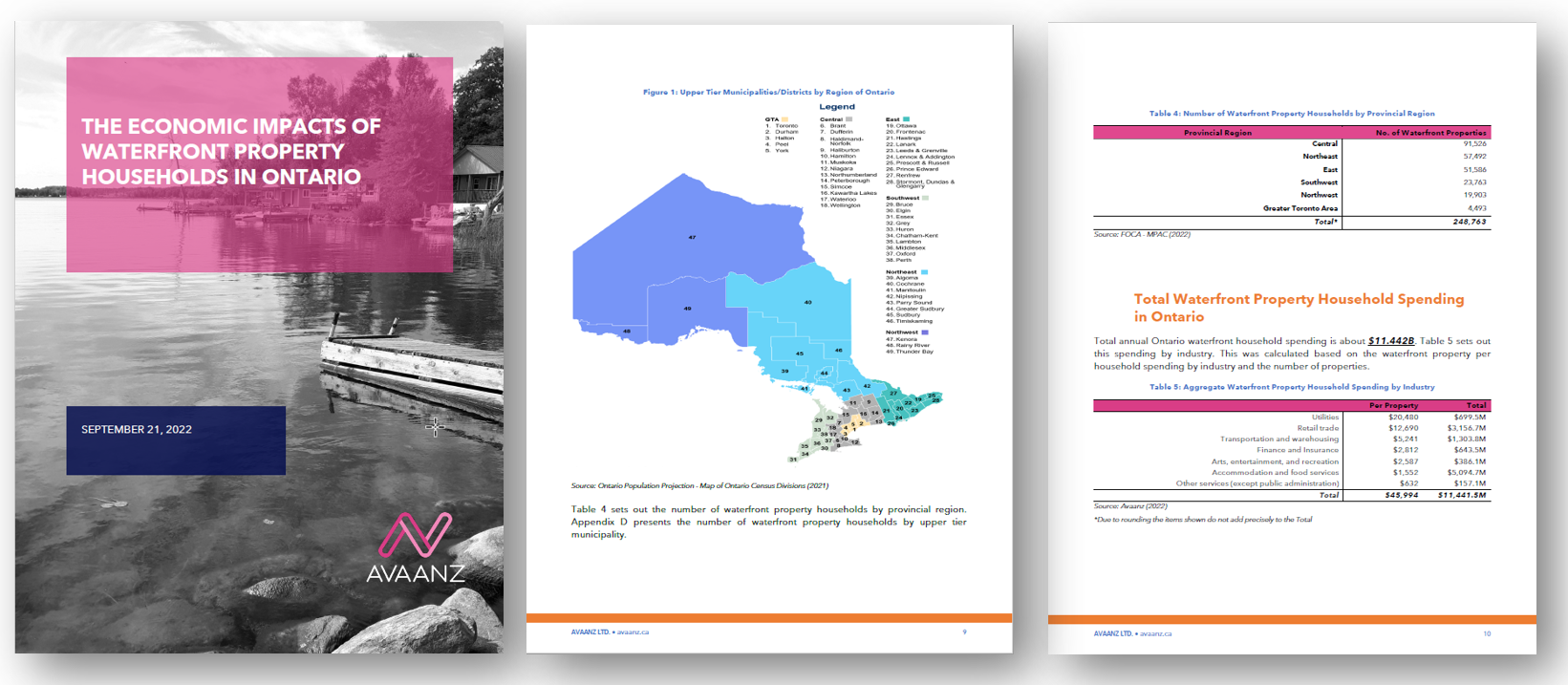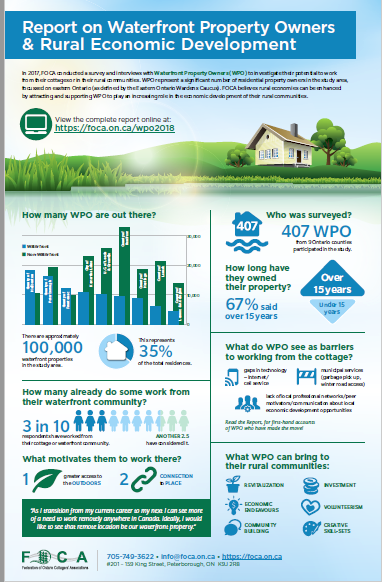
Waterfront property owners (WPO), whether seasonal or permanent residents, are a significant force in Ontario.
The annual property taxes alone on the estimated $75 billion of privately-owned residential cottage real estate is over $700 million, directly supporting local governance, programs, and infrastructure in more than 200 rural Ontario municipalities. “Cottage”-related household expenditures amount to billions of dollars every year.

Until now, and despite this significant footprint, there has never been a comprehensive review of this sector, or any strategic planning related to how this sector of our rural population could be more thoughtfully embedded into regional planning and local economic development.

November 2022 – NEW Member resource:
October 18, 2022 – NEW report released by FOCA: The Economic Impacts of Waterfront Property Households in Ontario:
The report concludes that an estimated $11.44 billion was spent in 2021 by a quarter of a million waterfront property households across Ontario.
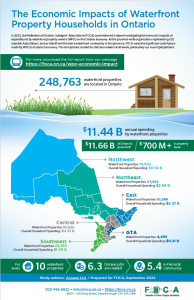 The report was authored by Avaanz Ltd using Statistics Canada’s Interprovincial Input-Output Model, 2022 property data from the Municipal Property Assessment Corporation (MPAC), and 2021 Statistics Canada annual average household spending data. See key data, below.
The report was authored by Avaanz Ltd using Statistics Canada’s Interprovincial Input-Output Model, 2022 property data from the Municipal Property Assessment Corporation (MPAC), and 2021 Statistics Canada annual average household spending data. See key data, below.
Click the image at the side (or here) to open an infographic summarizing the report’s findings.
Read FOCA’s Media Release about the report (download PDF, 1 page)
About the release, Haldimand-Norfolk MPP Bobbi Ann Brady said: “The tourism economy is huge in Haldimand-Norfolk, from cottages along Lakeshore Road in Haldimand in the east of the riding to Long Point in the west. Contributions of cottagers to our lakeside downtowns are visible in the transformation from hopping, busy villages in the summer to sleepy towns in the winter.”
FOCA Members are invited to login below to download a digital copy of the 27-page report, or contact FOCA to request a copy, which includes a breakdown by upper tier municipalities.
You're missing members-only content!
The following resources are only available to members of our Member Associations & current Friends of FOCA (our annual supporters). If you are already registered on the FOCA website, please login below with your Username and Password.
Need help with your login? Contact us for assistance during business hours. Not yet a Member Association? Find out why you should be!
Key data from the 2022 FOCA WPO Economic Impact report:
- 248,763 waterfront properties across the province
- $11.44 billion spent by all waterfront property households in 2021
- $45,994 average waterfront property household spending (as a % of Statistics Canada’s 2021 annual household spending; see Appendix C of the report for details)
- $6.91 million in labour income, $11.66 million in GDP generated by these dollars spent.
- Over 150,000 jobs are generated annually in Ontario by the contributions of waterfront property household spending.
- For every 10 waterfront properties located in a community, on average 6.3 jobs are created in the Province of Ontario, of which 5.4 jobs are in the waterfront property community itself.
Related Media Coverage:
- October 2022 – Cottagers generate big bucks and job creation in small communities, report says (as reported Oct.19 in MyMuskokaNow; Oct.19 in MyBarrysBayNow; Oct.20 in MyBancroftNow)
Statistics about Second Homes in Muskoka:
The 2023 Muskoka Second Home Study has been released by the District of Muskoka. Some highlights of this year’s release:
- half of the seasonal population is over age 55
- 96.7% of second homes in Muskoka are located on waterfront properties
- 1 in 10 survey respondents plan to eventually live permanently at their current seasonal home, with an average of 6 years until their planned move
- 11% of second homes are rented in Muskoka, an increase from 7.3% in 2017.
Download a digital copy of the study here (PDF, 40 pages)
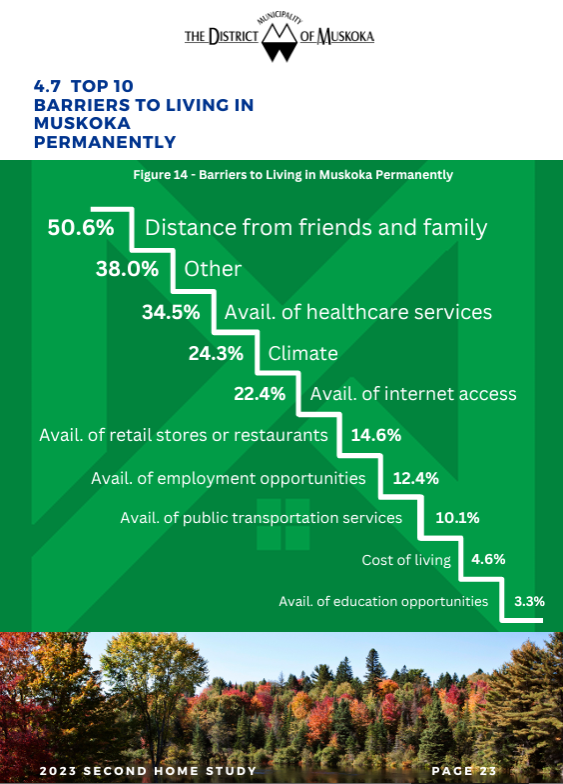
Earlier Regional FOCA Report (2018):
In 2017-18, FOCA undertook a study to articulate the significance of waterfront property owners (WPO) as vital economic contributors to rural communities in Ontario. This study speaks to the opportunity of having WPO contribute to and support the local economy beyond their role as “consumers.”
Click the image at the side (or here) to download an Infographic summarizing some key findings from the 2018 Report (PDF, 1 page)
WPO represent a significant number of total residents in many rural Ontario municipalities, which are otherwise facing increasing out-migration to urban centres. This study features eastern Ontario in particular, where tourism and a thriving cottage industry play key economic roles and where seasonal residents are spending more time at their second homes, with some choosing to relocate there, permanently. Within the eastern Ontario study region, consisting of 9 upper-tier municipalities, it was estimated that in 2012 there were 95,587 waterfront property owners, representing 35.4% of total residential properties. Based on this significant presence, municipalities of this region were the primary focus of this study.
FOCA Members are invited to login below to download a digital copy of the 56-page report, or contact FOCA to request a copy.
You're missing members-only content!
The following resources are only available to members of our Member Associations & current Friends of FOCA (our annual supporters).
If you are already registered on the FOCA website, please login below with your Username and Password.
Need help with your login? Contact us for assistance during business hours. Not yet a Member Association? Find out why you should be!
